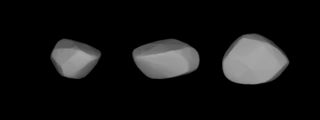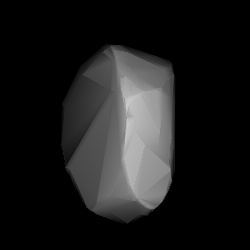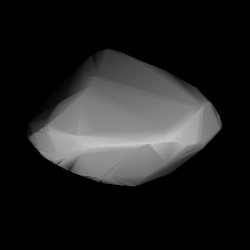
1743 Schmidt, provisional designation 4109 P-L, is a dark background asteroid from the inner regions of the asteroid belt, approximately 19 kilometers in diameter. It was discovered during the Palomar–Leiden survey on 24 September 1960, by astronomers Ingrid and Cornelis van Houten at Leiden, on photographic plates taken by Tom Gehrels at Palomar Observatory in California. The C-type asteroid has a rotation period of 17.5 hours. It was named for the optician Bernhard Schmidt.
2023 Asaph, provisional designation 1952 SA, is a dark asteroid from the outer regions of the asteroid belt, approximately 21 kilometers in diameter. It was discovered on 16 September 1952, by astronomers of the Indiana Asteroid Program at Goethe Link Observatory in Indiana, United States.
Pawlowia, provisional designation 1923 OX, is a background asteroid from the central regions of the asteroid belt, approximately 20 kilometers in diameter. It was discovered on 5 October 1923, by Soviet astronomer Vladimir Albitsky at the Simeiz Observatory on the Crimean peninsula. The asteroid was named after Russian physiologist and Nobelist Ivan Pavlov.

1039 Sonneberga, provisional designation 1924 TL, is a dark background asteroid, approximately 34 kilometers in diameter, located in the central region of the asteroid belt. It was discovered on 24 November 1924, by German astronomer Max Wolf at Heidelberg Observatory in southwest Germany. The asteroid was named for the German city of Sonneberg, where the Sonneberg Observatory is located.
1179 Mally, provisional designation 1931 FD, is an asteroid and long-lost minor planet from the central region of the asteroid belt, approximately 13 kilometers in diameter. Discovered by Max Wolf in 1931, the asteroid was lost until its rediscovery in 1986. The discoverer named it after his daughter-in-law, Mally Wolf.
1031 Arctica, provisional designation 1924 RR, is a dark asteroid from the outer region of the asteroid belt, approximately 75 kilometers in diameter. It was discovered on 6 June 1924, by Soviet−Russian astronomer Sergey Belyavsky at Simeiz Observatory on the Crimean peninsula. It was named for the Arctic Sea.
1049 Gotho, provisional designation 1925 RB, is a carbonaceous asteroid from the outer region of the asteroid belt, approximately 53 kilometers in diameter. It was discovered on 14 September 1925, by German astronomer Karl Reinmuth at Heidelberg Observatory in southwest Germany. Although the name of the asteroid is a masculine German name, it is not known to refer to a particular individual.
1123 Shapleya, provisional designation 1928 ST, is a stony Florian asteroid from the inner regions of the asteroid belt, approximately 11 kilometers in diameter. It was discovered on 21 September 1928, by Russian astronomer Grigory Neujmin at Simeiz Observatory on the Crimean peninsula. It was named after American astronomer Harlow Shapley.

1132 Hollandia, provisional designation 1929 RB1, is a stony asteroid from the middle region of the asteroid belt, approximately 27 kilometers in diameter. It was discovered on 13 September 1929, by Dutch astronomer Hendrik van Gent at Leiden Southern Station, annex to the Johannesburg Observatory in South Africa. It was named for the region Holland in the Netherlands.
1295 Deflotte, provisional designation 1933 WD, is a carbonaceous asteroid from the outer regions of the asteroid belt, approximately 48 kilometers in diameter. It was discovered on 25 November 1933, by French astronomer Louis Boyer at the Algiers Observatory in Algeria, North Africa. The asteroid was named after the discoverer's nephew.

1241 Dysona, provisional designation 1932 EB1, is a dark background asteroid from the outer regions of the asteroid belt, approximately 77 kilometers in diameter. It was discovered on 4 March 1932, by English astronomer Harry Edwin Wood at the Union Observatory in Johannesburg, South Africa. The asteroid was named after English astronomer Frank Watson Dyson.
1233 Kobresia, provisional designation 1931 TG2, is a carbonaceous background asteroid from the central regions of the asteroid belt, approximately 33 kilometers in diameter. It was discovered on 10 October 1931, by German astronomer Karl Reinmuth at the Heidelberg Observatory in southwest Germany. The asteroid was named for the grass-like flowering plant Kobresia, a genus in the sedge family.
4944 Kozlovskij, provisional designation 1987 RP3, is a carbonaceous Witt asteroid from the central regions of the asteroid belt, approximately 10 kilometers (6 miles) in diameter. It was discovered on 2 September 1987, by Soviet astronomer Lyudmila Chernykh at the Crimean Astrophysical Observatory in Nauchnij, on the Crimean Peninsula. The asteroid was named for Russian opera singer Ivan Kozlovsky.
3066 McFadden, provisional designation 1984 EO, is a stony background asteroid from the central regions of the asteroid belt, approximately 15 kilometers in diameter. It was discovered on 1 March 1984, by American astronomer Edward Bowell at the Anderson Mesa Station near Tucson, Arizona. It was named for American planetary scientist Lucy-Ann McFadden. The assumed S-type asteroid has a rotation period of 13.8 hours.
2043 Ortutay, provisional designation 1936 TH, is a dark asteroid from the outer regions of the asteroid belt, approximately 45 kilometers in diameter. The asteroid was discovered by Hungarian astronomer György Kulin at the Konkoly Observatory, Budapest, on 12 November 1936. It was named after Hungarian ethnographer Gyula Ortutay.

2111 Tselina is a stony Eos asteroid from the outer regions of the asteroid belt. It was discovered on 13 June 1969, by Soviet astronomer Tamara Smirnova at Crimean Astrophysical Observatory in Nauchnij, on the Crimean peninsula. The S-type asteroid has a rotation period of 6.6 hours and measures approximately 23 kilometers in diameter. It was later named after the Soviet Virgin Lands Campaign.
1323 Tugela, provisional designation 1934 LD, is a dark background asteroid from the outer regions of the asteroid belt, approximately 60 kilometers in diameter. It was discovered on 19 May 1934, by South African astronomer Cyril Jackson at the Union Observatory in Johannesburg. The asteroid was named for the Tugela River in western South Africa.

1186 Turnera, provisional designation 1929 PL, is a stony Eoan asteroid from the outer regions of the asteroid belt, approximately 36 kilometers in diameter. It was discovered on 1 August 1929, by South African astronomer Cyril Jackson at the Union Observatory in Johannesburg. The asteroid was later named after British astronomer Herbert Hall Turner.
1461 Jean-Jacques, provisional designation 1937 YL, is a metallic asteroid from the outer region of the asteroid belt, approximately 34 kilometers in diameter. It was discovered on 30 December 1937, by French astronomer Marguerite Laugier at Nice Observatory in southern France, who named it after her son Jean-Jacques Laugier.
(7563) 1988 BC, provisional designation 1988 BC, is a background asteroid from the central region of the asteroid belt, approximately 16 kilometers in diameter. It was discovered on 16 January 1988, by Japanese amateur astronomer Takuo Kojima at the YGCO Chiyoda Station in the Kantō region of Japan. The asteroid has a rotation period of 6.5 hours.






